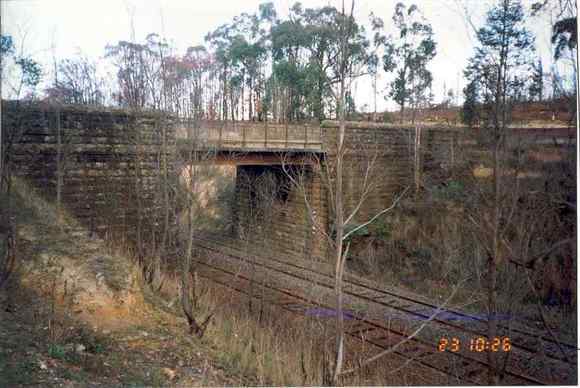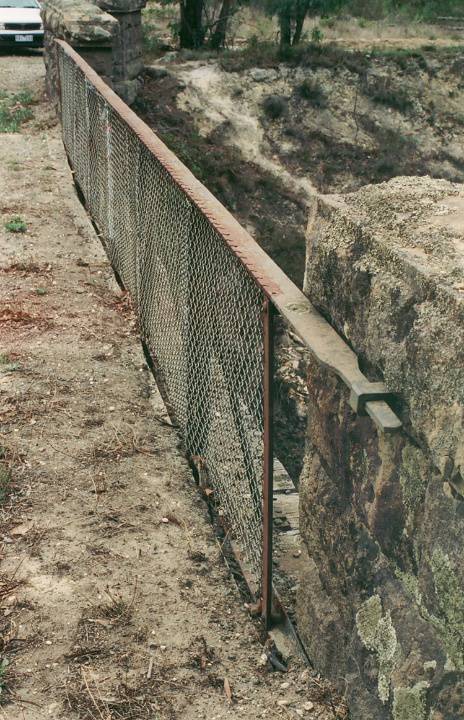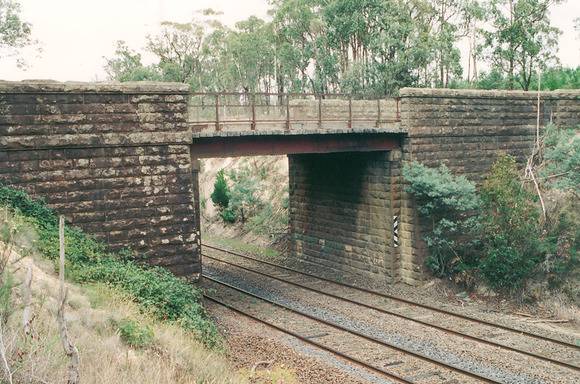| Back to search results » | Back to search page » |
|
Middle Gully Bridge over Melbourne-Bendigo Railway
LocationOff Middle Gully Road, 1.5 km from Nursery Road, West of Macedon,, MACEDON VIC 3440 - Property No B7318
File NumberB7318LevelState |
|
Statement of Significance
What is significant? The Middle Gully Bridge is a bluestone and wrought iron road over rail bridge situated on the Melbourne Bendigo Railway about 1.5 km north of Macedon. It was built in 1862 and is one of a group of similar stone or brick and iron girder bridges on this line.
How is it significant? The Middle Gully Bridge is significant for aesthetic/architectural, historic, and scientific (technical) reasons at a State level.
Why is it significant? The Middle Gully bridge is of historical and technical significance as one of the earliest metal plate girder road bridges in Victoria. The association of the bridge with the Melbourne Mount Alexander and Murray River Railway is significant, not only because of the large scale of public works associated with the construction of this line and its importance to the economic development of the colony, but also because of the key role that this project played in introducing the use of riveted wrought-iron plate girders to Victoria for both railway and road bridge construction. Prior to 1870 there were very few metal road bridges of any type built in Victoria and of the surviving examples attributed to this period which appear to retain their original riveted wrought-iron plate girders, all were associated with the construction of the Melbourne-Bendigo, Ballarat-Geelong, or Melbourne-Brighton Railways.
The Middle Gully Bridge is similar to several other metal road bridges over the same line. These are significant as a group, which represents an outstanding historical event and engineering achievement. The very intact condition and early date of the Middle Gully Bridge provide the potential to yield important information about the introduction of this style of bridge on the Melbourne Mount Alexander and Murray River Railway and to the whole of Victoria more generally.
The Middle Gully Bridge, represents a slight variation of the form, as it lacks the projecting pilasters. The development of composite masonry and wrought iron bridge construction as demonstrated in this bridge may also reflect the crisis of the stone mason's strikes of 1858-61 and a subsequent change in bridge design which this event may have caused.
The bridge demonstrates the high engineering standards and fine workmanship which are characteristic of the Bendigo Railway and provides a marker for the importation and adaptation of British engineering and technology, based on the wealth of the gold rushes and increasing political and financial power of the new Victorian Colonial Government.
The combination of masonry abutments and metal girders in the design of the bridge is characteristic of the Bendigo Line which was engineered to British main-line standards under the influence of Andrew Clarke and given the stamp of approval by the British Inspecting Engineer Isambard Kingdom Brunel, one of history's most famous and most influential engineers.
The bridge and the rail route are of historical significance as part of the first main country trunk route linking the goldfields with the ports of Geelong and Melbourne (the other line being the contemporary Geelong-Ballarat line). The provision of access across this line was subject to political debate and often resulted in bridges of a very high engineering standard serving little used roads and private access. In the case of the Middle Gully Bridge, while there was a connection between the settlement of Middle Gully (which had a Primary School between 1864 and 1897) and farming districts to the west, three other rail over bridges and a level crossing at Macedon Station provided access across the rail in this area. It is possible that some value was placed on the bridge as an access from the saw mills and later hill-station properties of Mount Macedon towards the north east.
The Middle Gully Bridge is of aesthetic significance for the finely detailed and balanced execution of the design, which successfully blends the disparate materials of wrought iron and bluestone. In contrast to the other metal girder road over rail bridges on the line, Middle Gully dispenses with the projecting splayed pilasters either side of the abutments, perhaps because the deep cutting reduces the bulk of the wing walls, making them unnecessary.The design solves the challenging problems for early bridge engineers and designers of incorporating metal girders and results in a unique design solution which uses string courses to define structural components such as the foundation plinths and girder sills, and balances the relatively slender girder with parapet walls of a similar scale. While it lacks the curved and tapered handrail brackets of the Harpers Lane and Gisborne Kilmore Road bridges, the proportions of the wrought iron fencing are maintained. The string courses also carry the horizontal lines of the girders and handrails through the length of the structure, abutments and wing walls. In its original form the corrugated galvanised iron balustrade panels would have created a more solid profile to the structure.
Classified: 30/04/2005
Group
Transport - Rail
Category
Railway Bridge/ Viaduct






